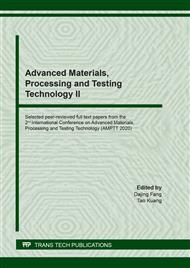[1]
(a) Cami-Kobeci, G.; Slatford, P. A.; Whittlesey, M. K.; Williams, J. M. J. Bioorg. Med. Chem. Lett. 2005, 535; (b) Hamid, M. H. S. A.; Williams, J. M. J. Chem. Commun.2007, 725.
Google Scholar
[2]
(a) M. H. S. A. Hamid, C. L. Allen, G. W. Lamb, A. C. Maxwell, H. C. Maytum, A. J. A. Watson, J. M. J. Williams, J. Am. Chem. Soc. 2009, 131, 1766 – 1774; (b) D. Hollmann, A. Tillack, D. Michalik, R. Jackstell, M. Beller, Chem. Asian J. 2007, 2, 403 – 410; (c) M. H. S. A. Hamid, J. M. J. Williams, Tetrahedron Lett. 2007, 48, 8263 – 8265.
DOI: 10.1021/ja807323a
Google Scholar
[3]
Ryoko Kawahara, Ken-ichi Fujita, and Ryohei Yamaguchia, Adv. Synth. Catal.2011,353, 1161–1168.
Google Scholar
[4]
(a) S. Michlik and R. Kempe, Chem.–Eur. J., 2010, 16, 13193;(b) S. Michlik, T. Hille and R. Kempe, Adv. Synth. Catal., 2012, 354, 847.
DOI: 10.1002/adsc.201100554
Google Scholar
[5]
(a) Sundberg, R. J. In ComprehensiVe Heterocyclic Chemistry II; Bird, C. W., Ed.; Pergamon: Oxford, 1996; Vol. 2, pp.119-206. (b) Gribble, G. W. J. Chem. Soc., Perkin Trans. 1 2000, 1045.
Google Scholar
[6]
Iritani, K.; Matsubara, S.; Utimoto, K. TetrahedronLett. 1988, 29, 1799. (b) Takeda, A.; Kamijo, S.; Yamamoto, Y. J.Am. Chem. Soc. 2000, 122, 5662.
Google Scholar
[7]
Tokunaga, M.; Ota, M.; Haga, M.; Wakatsuki, Y. Tetrahedron Lett. 2001, 42, 3865.
Google Scholar
[8]
Ken-ichi Fujita, Kazunari Yamamoto, and Ryohei Yamaguchi, Org. Lett., Vol. 4, No. 16, (2002).
Google Scholar
[9]
O'Hagan, D. Nat. Prod. Rep. 1997, 14, 637.
Google Scholar
[10]
Felpin, F.-X.; Lebreton, J. Eur. J. Org. Chem. 2003, 3693 and references therein.
Google Scholar
[11]
Ken-ichi Fujita, Takeshi Fujii, and Ryohei Yamaguchi Org. Lett., Vol. 6, No. 20, (2004).
Google Scholar
[12]
J. Marco-Contelles, E. P'erez-Mayoral, A. Samadi, M. C. Carreirasand E. Soriano, Chem. Rev., 2009, 109, 2652–2672.
Google Scholar
[13]
(a) R. Yamaguchi, K.-i. Fujita and M. Zhu, Heterocycles, 2010, 81, 1093–1140; (b) T. D. Nixon, M. K. Whittlesey and J. M. J. Williams, Dalton Trans., 2009, 753–762.
Google Scholar
[14]
(a) C. S. Cho,W. X. Ren andN. S. Yoon, J. Mol. Catal. A: Chem., 2009, 299, 117–120.
Google Scholar
[15]
Hili, R.; Yudin, A. K. Nat. Chem. Bio. 2006, 2, 284.
Google Scholar
[16]
Beccalli, E. M.; Broggini, G.; Martinelli, M.; Sottocornola, S. Chem. ReV. 2007, 107, 5318.
Google Scholar
[17]
(a) Koehler, N. K. U.; et al. J. Med. Chem. 2004, 47, 4989. (b) Banerjee, M.; Poddar, A.; Mitra, G.; Surolia, A.; Owa, T.; Bhattacharyya, B. J. Med. Chem. 2005, 48, 547.
Google Scholar
[18]
(a) Fieser, L. F.; Fieser, M. Reagents for Organic Synthesis; Wiley: NewYork,1967, 1, 1179.(b) Cremlyn, R. Organosulfur Chemistry: An Introduction; JohnWileyand Sons: New York, (1996).
Google Scholar
[19]
Steinhuebel, D.; Palucki, M.; Askin, D.; Dolling, U. Tetrahedron Lett.2004, 45, 3305.
Google Scholar
[20]
Caddick, S.; Wilden, J. D.; Judd, D. B. J. Am. Chem. Soc. 2004, 126,1024.
Google Scholar
[21]
Feng Shi, Man Kin Tse, Shaolin Zhou, Marga-Martina Pohl, Jo¨ rg Radnik, Sandra Hu¨bner, Klaus Ja¨hnisch, Angelika Bru¨ckner,§ and Matthias Beller, J. AM. CHEM. SOC. 2009, 131, 1775–1779.
Google Scholar
[22]
Feng Shi,Man Kin Tse, Xinjiang Cui, Dirk G_rdes, Dirk Michalik, KerstinThurow,Youquan Deng, and Matthias Beller* Angew. Chem. Int. Ed. 2009, 48, 5912 –5915.
DOI: 10.1002/anie.200901510
Google Scholar
[23]
Beno_t Blank, Stefan Michlik, and Rhett Kempe Chem. Eur. J. 2009, 15, 3790 –3799.
Google Scholar
[24]
Santosh Agrawal, Maud Lenormand, and Bel_en Martı´n-MatuteOrg. Lett., Vol.14, No. 6, (2012).
Google Scholar
[25]
(a) Roundhill, D. M. Chem. ReV. 1992, 92, 2. (b) Willis, M. C. Angew.Chem., Int. Ed. 2007, 46, 3402.
Google Scholar
[26]
K. Motokura, N.Nakagiri, K. Mori, T. Mizugaki, K. Ebitani, K. Jitsukawa, K.Kaneda, Org. Lett. 2006, 8, 4617 – 4620.
DOI: 10.1021/ol0619821
Google Scholar


